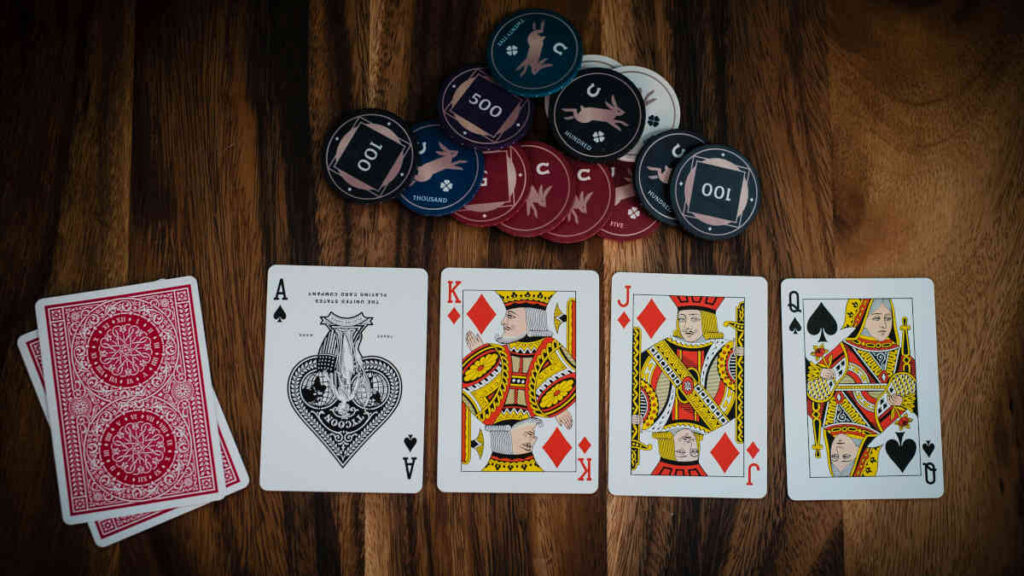If you’ve ever watched poker on TV, or even watched your friends play poker in a home game, you have probably heard them talk about their “kicker,” as the reason they won or lost a poker hand.
But what exactly is a kicker in poker, when does it come into play, and how does one determine their kicker?
In this article, we will answer all the questions you might still have about poker kickers and teach you how to build your poker strategy around playing hands with superior kickers.
What Is a Poker Kicker?
Explained in simple terms, poker kicker is the highest card you hold alongside your “made” hand. A made hand can be a hand like one pair or two pair, and the kicker is the highest card not a part of that combination.
For example, if you hold A♠A♥K♦9♥3♣, you have a pair of Aces, with a King kicker. This card is used to determine the winner in cases when two players have the same hand.
For example, if the board runs A♣J♦9♥7♣2♥, and you hold A♦K♦, you have a pair of Aces with a King kicker. If your opponent has a hand like A♥Q♥ or A♥10♥, you will win the pot because you have a stronger kicker.
Kickers don’t come into play with hands that require five cards to make, such as straights, flushes, and full houses.
So, let’s take a look at how kickers work with different poker hands.
Poker Kicker with High Card
The weakest poker hand in which the kicker comes into play is high card. If two or more players have the same high card, their next highest card is used to determine the winner.
In high card situations, kickers come into play quite often, as multiple players may share the high card.
For example, on a board of K♦9♠8♣4♥2♣, players show down A♥Q♦ and A♣7♥. Both players have Ace-high, but the first player’s hand is better thanks to their Queen kicker.
If two players have the same kicker to go with their high card, the next highest card is looked at, until a tiebreaker is finally found.
Poker Kicker with One Pair
Two players having the same one pair hand is quite a common situation in poker. In these situations, the kicker is once again used to break the tie.
For example, on a board of K♦Q♥8♣7♠5♣, two players hold K♠J♠ and K♥10♥, respectively.
Both players have a pair of Kings, and the Queen is their shared kicker. In this case, the next highest card is taken into consideration as the kicker.
Since the first player holds a Jack, and the other holds a Ten, the Jack kicker plays, and the first player wins the pot.
Poker Kicker with Two Pair
Two pair situations that require a tiebreaker by kicker are a bit less common, but they do happen, especially on paired boards.
For example, a board may run out A♥A♦Q♠6♣5♦, with players holding Q♣9♣ and Q♥7♥.
In this hand, both players hold two pair, Aces and Queens. The pair of Aces on the board is shared, while each player’s Queen connects with the one on the board.
In this case, the poker kicker comes into play once again. One player has a Nine as their highest non-paired card, while the other has a Seven.
For that reason, the player with the Nine kicker wins the hand if it goes to a showdown.
Poker Kicker with Three of a Kind
Three of a kind is another hand that can be impacted by the kicker. There are two ways to make three of a kind in Texas Hold’em, and the kicker only plays with one of them.
If a player makes a set (pocket pair + one card on the board), no one else can have the same three of a kind, making the kicker a moot point.
On the other hand, if there is a pair on the board, two players can have the same three of a kind with different kickers.
For example, on a board of A♣9♥9♠6♣2♥, players might hold 10♣9♣ and 9♦8♦, respectively.
In this case, both players have three of a kind, Nines, but their kickers are not the same. The first player’s Ten kicker plays, and is enough to win the hand.
Poker Kicker with Four of a Kind

The final hand in poker that can be impacted by the kicker is four of a kind, and the only time this happens is when four of the same cards are dealt on the board.
If anyone makes four of a kind while holding any of the four cards, no one else can hold the same four of a kind, which makes the kicker irrelevant.
But, if the board runs 7♠7♥7♣7♦5♣, everyone still in the hand now has four of a kind. In this situation, the cards in the players’ hands begin to matter.
For example, if one player holds A♣3♣ and the other holds K♠Q♠, the player with the Ace in their hand will win, since their hand will be four of a kind with an Ace kicker.
What Is a Counterfit Kicker?
As we already explained, the poker kicker is the highest card in a player’s hand that’s not a part of their made hand.
Since five cards play in a Texas Hold’em hand, there are situations in which the player’s kicker can be counterfitted and no longer play by the river.
For example, on a board of A♠9♣3♥, two players hold A♦8♦ and A♥7♥. At this moment, the first player’s Eight kicker is dominating their opponent’s hand.
However, imagine if the turn brings the K♠ and the river brings the Q♦. Both players now hold a pair of aces, while the King, Queen, and Nine play as their highest unpaired cards.
The kickers both players held in the hole no longer play, as the turn and the river counterfeit them both, leading to a split pot.
Choosing Poker Hands Based on Kickers
Most Texas Hold’em hands are won by one pair, and many are won by high card or two pair as well. Since kickers can be crucial in determining the value of these hands, savvy poker players consider their kickers from the early going in a poker hand.
If you watch the pros play, you will notice them always playing a hand like AK aggressively, and rarely folding it before the flop. On the other hand, a hand like A7 will routinely hit the muck. Have you ever thought about why this is?
Both hands can make a pair of Aces, which is a strong poker hand in absolute terms. However, if a lot of money goes into the pot, it’s very common for the other player to have a pair of Aces as well.
In these situations, the higher kicker is the tie breaker, and holding the King instead of some medium or small card can be all the difference you need.
The next time you are dealt a high card like an Ace or a King with a medium or small kicker, think twice about the value of that hand and the potential of losing a big pot when you flop top pair with an inferior kicker.
Using Low Poker Kickers to Your Advantage

While having a low kicker in poker is usually a disadvantage, there are some situations where having a lower kicker is preferable to having a medium one.
The most popular example of this is before the flop, when you face a raise. Hands like AK and AQ are usually good enough to continue here, by either calling or re-raising.
However, as kickers go down, hands like AT, A9, and A8 become problematic, and most professional players like folding these hands facing a raise, especially if they are not suited.
On the other hand, you will often see these same players re-raise with hands like A2s, A3s, A4s, and A5s.
If you are wondering why they are doing this, the answer is balance! They are including these hands in their re-raising hand ranges to ensure their preflop hand ranges are balanced, and that they aren’t only re-raising with their strongest hands.
The small suited Aces are selected because they have a few great properties. Having the Ace reduces the odds of the original raiser having one, being suited gives you the ability to make the nut flush, and having a small card with your Ace allows you to also make the bottom straight.
In the situations your opponent does call, they will often have cards that may interact with hands like AT or A9, but your 2, 3, 4, or 5 will often be “live.”
For example, if your opponent decides to call you with a hand like AJ, you may end up winning the hand by making a pair of Deuces or Treys by the river.
Don’t misunderstand this as a reason to play your baby suited Aces as monsters every time, but keep in mind that these hands have excellent properties that make them potential bluffing candidates in many situations.


